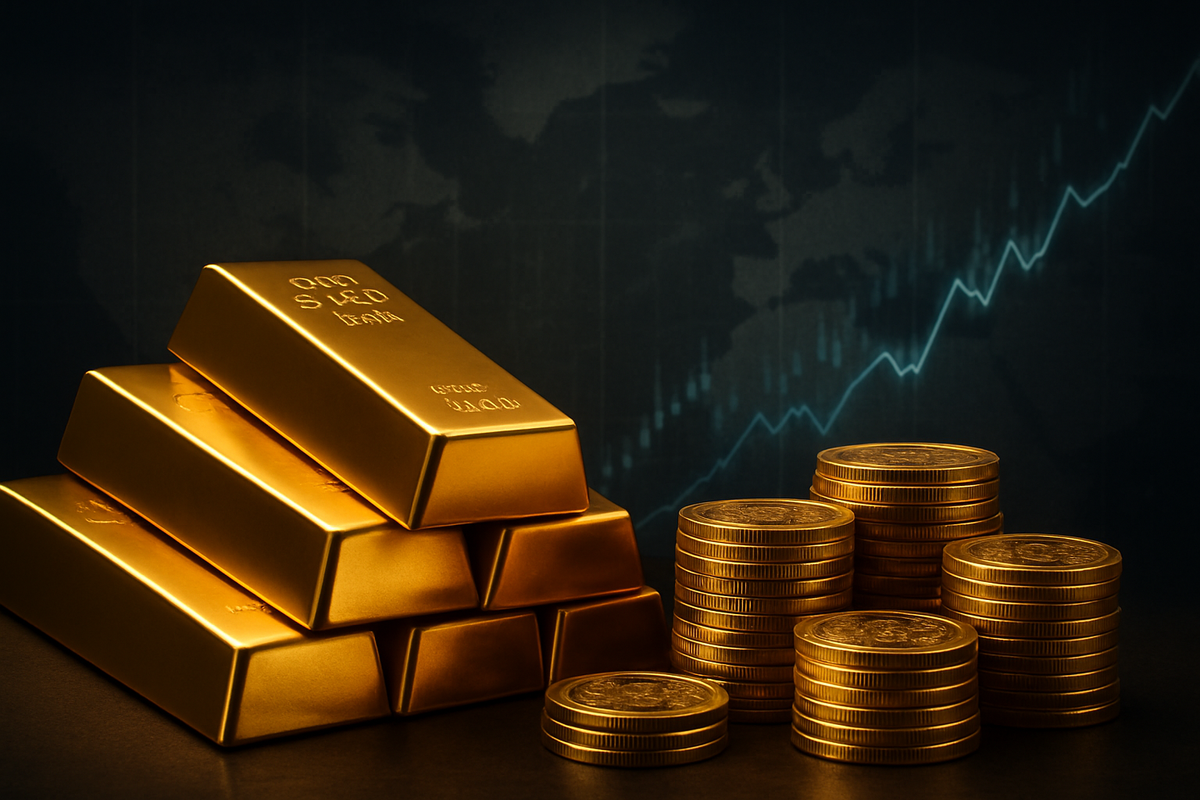
Gold prices concluded October 2025 with a remarkable performance, extending a bullish streak for the third consecutive month and solidifying its position as a premier safe-haven asset. The precious metal witnessed significant monthly gains, even touching an all-time historical record high before undergoing a "healthy correction." This robust rally, which saw gold climb 4.5% over the month and surge over 46% since the start of the year, underscores a profound shift in investor sentiment amidst persistent global economic uncertainties, inflationary pressures, and geopolitical tensions. The immediate implications point to a sustained demand for tangible assets, challenging traditional market dynamics and prompting a re-evaluation of portfolio strategies for investors worldwide.
October 2025 proved to be a pivotal month for gold, characterized by both unprecedented highs and strategic market adjustments. The precious metal's journey began with a strong upward trajectory, culminating in an all-time record price of approximately $4,382 per ounce between October 7th and 20th. This surge was primarily fueled by a confluence of factors, including an intensified safe-haven demand driven by global economic volatility, continued inflationary concerns, and escalating geopolitical instability. A weaker US dollar further amplified gold's attractiveness, making it more affordable for international buyers.
A significant contributor to gold's sustained ascent was the vigorous activity of central banks globally. The third quarter of 2025 alone saw central banks collectively acquire 220 tons of gold, marking a substantial 28% increase from the previous quarter and signaling a renewed appetite for the metal as a reserve asset. Kazakhstan emerged as the largest buyer, while Brazil re-entered the market with its first purchase in over four years, highlighting a broad institutional endorsement of gold's value. Moreover, the US Federal Reserve's decision in October to cut interest rates by 25 basis points—its second such reduction this year—provided an additional tailwind, as lower interest rates typically reduce the opportunity cost of holding non-yielding assets like gold.
However, the rally was not without its strategic pauses. Following its record peak, gold experienced a technical "healthy correction," retreating to a range of $3,980-$4,100 by month-end, representing roughly a 5.8% decline from its apex. This pullback was largely attributed to profit-taking by investors and remarks from Fed Chair Jerome Powell, who downplayed the likelihood of further aggressive rate cuts in December, causing some temporary market jitters. Additionally, a tentative trade deal between the US and China contributed to a short-term reduction in geopolitical risk premiums, playing a minor role in the correction. Initial market reactions, while acknowledging the short-term volatility and correction, largely maintained a bullish long-term outlook. Analysts widely interpreted the pullback as a normal consolidation phase within a broader bull market, rather than a fundamental shift. Institutional investors, unlike previous rallies, were noted for providing consistent demand, signaling a fundamental shift in how precious metals are perceived in a highly uncertain economic climate. Major financial institutions have since revised their 2025 and 2026 price targets upwards, with some bold projections forecasting gold to reach $5,000 per ounce by 2026, reinforcing the sentiment that any dips below $4,000 represent prime buying opportunities.
Companies Navigating Gold's Ascent: Winners and Losers
The sustained rally in gold prices during October 2025 created a distinct bifurcation in the financial markets, producing clear winners and losers across various sectors. At the forefront of the beneficiaries are public gold mining companies, whose fortunes are intrinsically tied to the price of the precious metal. As gold soared to record highs, miners experienced a direct uplift in revenues and profit margins, given their operational leverage. Companies like SSR Mining Inc. (NYSE: SSRM), Coeur Mining Inc. (NYSE: CDE), Hecla Mining Co. (NYSE: HL), and AngloGold Ashanti PLC (NYSE: AU) all reported impressive 30-day returns, with some, like SSR Mining, boasting an exceptional 281.79% one-year performance as of late October. Even industry giants such as Newmont Corp. (NYSE: NEM), one of the world's largest gold producers, reported strong Q3 2025 results with record free cash flow, improving its cost guidance for the year. Similarly, Kinross Gold Corp. (NYSE: KGC) and Agnico Eagle Mines (NYSE: AEM) saw substantial year-to-date gains, underscoring the direct positive correlation between gold prices and mining profitability.
Beyond direct mining operations, other segments of the precious metals market also thrived. Gold streaming and royalty companies, such as Royal Gold Inc. (NASDAQ: RGLD), FrancoNevada (NYSE: FNV), and Triple Flag Precious Metals Corp. (NYSE: TFPM), emerged as significant winners. These firms provide upfront capital to miners in exchange for a percentage of future production or revenue, benefiting from rising gold prices without bearing the direct operational risks of mining. Their business model often translates into stable cash flows and attractive dividends during bullish gold markets. Precious metals Exchange-Traded Funds (ETFs) also witnessed substantial inflows and appreciation. Funds like SPDR Gold Shares (NYSEARCA: GLD) and iShares Silver Trust (NYSEARCA: SLV), which hold physical metal, provided investors with direct exposure to the rally, with gold ETFs, on average, delivering over 53% returns year-to-date in 2025.
Conversely, the elevated gold prices presented considerable challenges for certain industries. Jewelry retailers, in particular, found themselves on the losing end. The soaring cost of gold, their primary raw material, directly impacts product affordability, leading to a noticeable decline in consumer demand. This translates into margin compression and reduced sales volumes as consumers either opt for lighter pieces, postpone purchases, or seek alternatives. For instance, Titan Company (NSE: TITAN), a major Indian jewelry retailer, reported lower domestic sales growth in Q3 2025, specifically attributing it to decreased demand for higher-carat jewelry. Similarly, industrial users of gold, across sectors like electronics, nanotechnology, and medical devices, faced increased input costs, potentially squeezing their profit margins if these additional expenses cannot be absorbed or passed on to consumers.
Furthermore, financial entities that had taken short positions on gold or gold mining stocks, or those with negative gold hedging positions, would have incurred substantial losses during October's rapid ascent. The market's bullish momentum caught many off guard, punishing those betting against the precious metal. This highlights the inherent risks of speculating against strong market trends, especially in a commodity driven by a complex interplay of economic uncertainty, monetary policy, and geopolitical dynamics. The clear divide between winners and losers underscores gold's role as both a barometer of market sentiment and a powerful determinant of profitability across its value chain.
Gold's Broader Significance: A Barometer of Global Shifts
The robust performance of gold in October 2025 transcends a mere commodity price movement; it serves as a powerful barometer of deep-seated anxieties and structural shifts within the global financial system. This rally is not an isolated incident but rather a culmination of several intertwined macroeconomic and geopolitical trends. Persistent geopolitical instability, exemplified by ongoing conflicts like the Israel-Hamas conflict and the Russia-Ukraine war, alongside simmering US-China tensions and trade disputes, has significantly amplified gold's traditional role as a safe-haven asset. In an environment rife with uncertainty, gold's intrinsic value and perceived independence from governmental control offer a tangible refuge for capital.
Furthermore, the specter of persistent inflationary pressures continues to bolster gold's appeal as a hedge against currency debasement. With the US CPI still registering a 3% year-over-year increase in September 2025, exceeding the Federal Reserve's target, investors are increasingly seeking assets that can preserve purchasing power. This inflationary backdrop, coupled with expectations of monetary policy easing—specifically, anticipated interest rate cuts by the Federal Reserve—creates a highly favorable environment for gold. Lower interest rates diminish the opportunity cost of holding non-yielding assets, making gold more attractive compared to traditional income-generating investments. A weakening US dollar further enhances this appeal, making gold more affordable for international buyers and driving global demand.
A critical structural shift underpinning gold's strength is the accelerating trend of central bank accumulation. Global central banks have been net purchasers of gold at multi-decade highs, with acquisitions projected to continue strongly into 2025 and 2026. This represents a deliberate strategy to diversify national reserves away from dollar-denominated assets, protect against inflation, insure against crises, and enhance monetary sovereignty—particularly among nations wary of the weaponization of reserve currencies through sanctions. This institutional buying provides a significant structural price floor for gold and validates its role as systemic risk insurance, with some countries, like India, even repatriating gold reserves.
Historically, gold's current rally echoes patterns seen in previous periods of profound economic and geopolitical upheaval. The 1970s bull market, characterized by double-digit inflation, oil shocks, and geopolitical crises, saw gold prices quadruple. Similarly, the decade-long ascent from the early 2000s to 2011 was fueled by the tech bubble burst, 9/11, massive money printing, and the 2008 global financial crisis. More recently, gold surged during the Great Recession and the COVID-19 pandemic, responding to unprecedented fiscal and monetary stimulus. These historical precedents underscore gold's consistent behavior as a crisis hedge, tending to cool only when stability and higher real interest rates return. The current environment, combining policy uncertainty, inflationary fears, and global instability, positions gold squarely in line with these historical patterns, suggesting a continued re-evaluation of traditional asset allocations and a strengthened role for the precious metal in both national reserves and individual investment portfolios.
What Comes Next for the Golden Metal
Following gold's extraordinary performance in October 2025, the market is bracing for a dynamic period characterized by continued volatility yet an overarching bullish sentiment. In the short term, investors should anticipate phases of consolidation and potential pullbacks as profit-taking naturally occurs after such significant gains. However, many analysts view these dips as strategic buying opportunities within a broader structural bull market. Near-term forecasts from institutions like Goldman Sachs project gold reaching $4,000 per ounce by mid-2026, while J.P. Morgan anticipates averages around $3,675 by Q4 2025, climbing towards $4,000 by mid-2026. Trading Economics offers even more immediate optimism, projecting $4,157.19 by the end of Q4 2025. These movements will remain highly sensitive to ongoing Federal Reserve monetary policy decisions, particularly the pace and extent of anticipated interest rate cuts, alongside evolving geopolitical landscapes and fluctuations in the US dollar's strength.
Looking further ahead, the long-term outlook for gold remains predominantly bullish, with many major financial institutions revising their forecasts upwards. The consensus for 2026 and beyond often clusters around the $4,000-$5,000 range. Some of the more aggressive projections envision gold reaching $5,055 by late 2026 and potentially soaring to $8,000 by 2028, according to J.P. Morgan, while Goldman Sachs maintains a $4,900 target for end-2026. This optimism is underpinned by several enduring factors: persistent central bank accumulation for reserve diversification, a likely environment of lower real interest rates due to anticipated Fed easing, sustained geopolitical tensions fueling safe-haven demand, and ongoing concerns about inflation. Conversely, the World Bank presents a more tempered view, forecasting a more modest 5% rise in 2026 and suggesting the rally might plateau or end by 2027, highlighting the divergence of expert opinions.
For investors, strategic pivots will be crucial. Implementing a dollar-cost averaging strategy can help mitigate the impact of short-term volatility, while buying on dips remains a favored tactic for long-term accumulation. Gold's role as a portfolio diversifier, offering resilience against unpredictable market conditions, becomes even more pronounced. Exposure can be gained through various vehicles, including physical gold, highly liquid gold-backed ETFs such as SPDR Gold Shares (NYSEARCA: GLD), or through investing in gold mining stocks like Newmont Corp. (NYSE: NEM), which offer leveraged exposure to price movements. The market presents opportunities stemming from sustained demand, a favorable monetary environment, and geopolitical headwinds, but also challenges like potential price volatility, a strong US dollar resurgence, or a significant de-escalation of global tensions. The most probable scenario appears to be a "Sustained Bull Run," driven by the confluence of supportive macroeconomic and geopolitical factors, with "Correction and Consolidation" being a moderate probability, and a "Bearish Reversal" remaining a lower-probability, but not impossible, outcome.
Comprehensive Wrap-up: Gold's Enduring Allure
Gold's robust performance in October 2025 serves as a powerful testament to its enduring allure and critical role in modern financial markets. The month's journey, from record-breaking highs to a strategic correction, underscored several key takeaways: gold's unparalleled safe-haven status amidst global turmoil, its efficacy as an inflation hedge against persistent price pressures, and a significant, structural shift in central bank and institutional demand towards diversification. This period marks not just a price rally, but a profound recalibration in global finance, driven by a desire for greater monetary sovereignty and resilience against systemic risks.
Moving forward, the gold market is expected to remain dynamic, influenced by a complex interplay of monetary policy, geopolitical developments, and economic indicators. While short-term volatility and profit-taking are probable, the underlying structural drivers—continued central bank accumulation, anticipated lower real interest rates, and ongoing global uncertainties—are poised to provide sustained support for prices. Analysts largely maintain a bullish long-term outlook, with many forecasting gold to remain well above the $4,000 mark and potentially climb towards $5,000 or even higher in the coming years.
The lasting impact of October's rally is a reinforced perception of gold as an "asset for all occasions," capable of performing well during both risk aversion and periods of broader market enthusiasm. Investors should approach the market with a strategic, long-term perspective. Key support levels, particularly around $4,000, should be watched for potential buying opportunities on dips. Diversification remains paramount, with gold forming a considered portion of a balanced portfolio. In the coming months, investors should closely monitor Federal Reserve communications on interest rates, global inflation data, geopolitical developments, and the strength of the US dollar. These factors will be instrumental in shaping gold's trajectory as 2025 concludes and 2026 unfolds, offering both challenges and compelling opportunities for those who understand its fundamental drivers.
This content is intended for informational purposes only and is not financial advice





